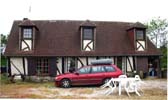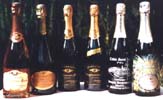



You are here: Home
   |

|
|
You are here: Home |
Professional background and experienceClick here to read a brief and more formal CV AdvertisingI began my first career in 1961 as a trainee in a London advertising agency - an apprenticeship covering all aspects of the writing, design, production and publication of publicity material. Writing had always been my great love, and I quickly moved to another agency to develop my skills as a specialist copywriter. Technical publicity, PR and journalismIn 1963 I became a technical sales promotion writer for Associated Electrical Industries (AEI), then the UK’s biggest electrical manufacturer. AEI produced everything from Hotpoint domestic appliances, through the first electronic telephone exchange to turbine-generators for major power stations. They also designed and built and one of the first genuinely commercial electronic digital computers, based on discrete germanium transistors, and offered a data-processing service to other forward-looking companies. I wrote the promotional material for both the system and the service in 1964, working closely with engineers and programmers. I remaining there - apart from a brief excursion into another advertising agency, also handling high-tech accounts - until 1967 when AEI was taken over and ’downsized’ by GEC. By now my portfolio was impressive enough to get me a new job before Arnold Weinstock ended my current one! I became a press officer at the Industrial Diamond Information Bureau, shifting my focus from electrical and electronic engineering to mechanical engineering, and from writing in-house brochures to producing press-releases and articles for the engineering press. Teacher trainingIn 1969 I left London to train as a primary teacher in Cornwall, specialising in art-and-craft, music and primary science. Special educationFrom college, I went into a school for children with severe learning difficulties (then referred to as ’mentally handicapped’ or, officially and horribly, ’severely subnormal’). I specialised in art-and-craft, particularly pottery and printmaking, but my technical interests made me teacher in charge of audio-visual aids - including the first video recorder and camera to be used in a Cornish school. After eight years I moved to Derby to join the senior management of a large residential school for boys with moderate learning difficulties and emotional and behaviour problems - still known officially as ’educationally submormal (moderate)’ or ’ESN(M)’ and ’maladjusted’. The first microsAbout a year later I met my very first microcomputer - a Tandy TRS-80. Shortly after this I had a chance to experiment with a Sinclair ZX-80, and then I managed to get a state-of-the-art classroom computer - a Commodore PET with 8K of memory, a tiny calculator-style keyboard, a 9-inch green screen and a built-in cassette drive. I taught myself to program in Microsoft Basic and began developing IT (or, as we called it then, even in special school, ’Computer Studies’) in my classroom. Part-time IT supportIn 1981, Derbyshire set up the Derbyshire Computer Assisted Learning Project, seconding 15 teachers for one day a week to develop and support the use of computers in schools. I was given a secondment to support the use of computers in special schools. The PET still ruled, but now I had a 32K machine with a 12-inch screen, a full-size keyboard and an external cassette drive. Shortly afterwards, I acquired a dual 5¼-inch disc drive and a printer. I began writing drill-and-practice, programmed-instruction and computer-managed learning software (involving random-access file-handling) for the special schools. Between 1981 and 1983 I was a co-opted member of National Advisory Committee for Microelectronics and Special Education, set up and managed by the Council for Educational Technology to steer work done by the Government’s Microelectronics Education Project (MEP) in the field of special educational needs. During 1983 I was seconded full-time to the for one term’s curriculum development work, developing both hardware and software to enable Sinclair ZX81 and Spectrum computers to be used by children with severe physical disabilities. Then along came the BBC Computer, with real graphics, colour and sound. All the old programs were translated into what looked then like real multimedia. By laboriously typing an Acorn User magazine assembly-language program that enabled a Beeb to drive a PET printer via a complicated cable which I had to make up, I had the first printing Beeb setup in Derbyshire. Full-time Advisory TeacherIn 1984 Derbyshire appointed its core team of four full-time Advisory Teachers for Computer Education, and I was appointed to the post with responsibility for special education. Because there was no commercial educational software yet, a great deal of time was still spent programming, and I produced a number of what were then highly innovative packages for children with special needs. This period culminated in two commercial products that stretched the Beeb close to its technical limits.
Tarka was a classic example of a good idea that failed because of under-investment and poor marketing, but I sold Predictype myself for some time before it was taken over - and ultimately abandoned - by Lander Software, who also marketed the Dundee system for PCs. It was a modest success but died with the BBC Computer. The online revolution began in 1984The other dramatic innovation at this time was the first use of communications technology by schools and colleges. Derbyshire was a front-runner in the use of The Times Network for Schools (TTNS), later BT Campus 2000, and in 1984 I became one if the LEA’s system managers. This allowed us to use email at a time when few people had even heard of it, using modems that received data at just 1200 bits per second and transmitted it at an unbelievable 75 bits per second. Everything you typed was sent to a remote server at the slow speed and returned to your desktop computer at the (relatively) fast speed before appearing on your screen. As a fairly brisk two-finger typist I could easily get half a line ahead of the system, and if you spotted an error the only way of correcting it was to delete back and re-type. We thought this systemw was wonderful! Team LeaderDuring the great GEST funding boom, the Derbyshire ICT Team grew to a total of 12 advisory teachers. I managed a team of six colleagues for a year in this ’golden age’, during which we were heavily involved in providing feedback to NCC on the draft National Curriculum IT orders. It was also during this time that DESCIT, the LEA ICT centre, having finally appointed a real programmer, developed the award-winning My World, My World 2 and My World for Windows framework packages. I was one of the brainstorming team that specified the software design, and developed many of the original screens and wrote the User Guides for all three versions. Away from special needsAfter GEST, the team shrank back to a total of 6 based in four areas. I took over the front-line support of all aspects of ICT in the City of Derby and South Derbyshire, working closely with nursery, infant, junior, primary and secondary schools, and with FE colleges and support services. I also developed a comprehensive diary-management system for advisers and advisory teachers, using Microsoft’s Access database-management system, which gave me a head-start in learning to use PCs and serious relational databases. DICE NewsFor ten years I edited Derbyshire LEA’s IT newsletter for schools, DICE News. This developed from a word-processed, daisywheel-printed and corner-stapled effort with a Letraset title to a professionally designed, desktop-published magazine. Because of the difficulty in persuading busy colleagues and teachers to write articles, I produced much of the content myself. Accredited trainerWhile in Derby, I took part in Derbyshire LEA’s accreditation scheme for trainers, operated in conjunction with CCDU at the University of Leeds, and received my accreditation in March 1995. Independent consultantIn March 1995 I took voluntary early retirement from Derbyshire LEA to become an independent educational ICT consultant. I maintained as much contact with schools as I could without undermining my friends and colleagues who were left in the Derby and Derbyshire advisory services. My major clients were BT CampusWorld, BT Education and Research Machines plc. CampusWorld was the first website aimed at children, with a large team of consultants developing content - and, in the process, becoming some of the first competent HTML programmers in the country. Between April 1995 and January 1999 I was responsible for writing and maintaining all three BT CampusWorld hypertext user support systems: The Online Guide, Interactive Help and The Virtual Textbook. I also originated two of the most interactive content areas on CampusWorld - The Database Workshop and (with two former Derbyshire colleagues Bob Gallear and Phil Noskeau) The Primary Science Interactive Workshop. These aimed to make the fullest possible use of World-Wide Web pages, electronic mail and discussion groups to provide both teachers and learners with real and relevant support in the curriculum-areas they addressed: data-handling in the classroom in all phases, and science at primary level. I developed the We Live Here! area on CampusWorld to encourage primary-phase schools to do quality local-area studies and then to share the results with other schools via electronic mail and discussion groups and by publishing them on the Web. This involved recruiting schools in all four home nations to a pilot project which was sadly cut short when the regulator ruled that BT could not cross-subsidised CampusWorld from its other businesses and it was taken over to become AngliaCampus. I found the new organisation’s educational values totally unsympathetic and opted not to stay with it. In my time with BT, though, I was a presenter on many of the hi-tech CampusWorld promotional roadshows during 1995, including a whistle-stop Scottish tour that took in Shetland, Inverness, Aberdeen, Dundee, Stirling and Dumfries. I managed the presenter programme for BT Education’s international conference Communicate ’95 in the Autumn of 1995, commissioning an international group of over 40 presenters. I was a co-presenter with Bruce Bond, one of the BT group’s most visionary Managing Directors, at a major educational marketing event in Belfast. And I designed and delivered teachers’ workshops for BT Education. After CampusWorld, working in partnership with Hardwick Infant School in inner-city Derby, I developed twelve suites of My World screens exclusively for RM’s Infant Window Box. Early in 1999 I was commissioned to edit some of the first Web content on European Schoolnet, a major new initiative by the European Union to encourage the use of communications technology by schools and colleges, particularly for international collaborative projects. Briefly, I provided ICT support for Derby and Derbyshire schools which were unable to obtain the necessary support from their LEAs. Then I also launched a support service for home computer users and a website creation and maintenance service for public-service and commercial clients, including George Dutton Ltd in Ashbourne. For most of 2000 I was contracted to re-develop and maintain Derby LEA’s own website, Derby Education Online. NHS Web Development ManagerIn April 2001 I was appointed Web Development Manager by Southern Derbyshire Health Authority, responsible for setting up and managing sites for the rapidly-evolving local NHS community. In 2002 the Health Authorities were abolished, and I found myself working for Derwent Shared Services, an agency hosted by Greater Derby Primary Care Trust. Heading a team of three, I was responsible for the following sites:
These sites had a lot of database-driven content which required me to become expert in Microsoft Active Server Pages (ASP) and Microsoft Access and SQL Server database systems. The same applied to the local pages for the www.nhs.uk local services information site, our own Information for Patients and the Public services and local health vacancies site. Towards the end of my time as Web Development Manager, I moved all these sites to a new hosting service that allowed us to deliver most content dynamically from an SQL Server database, which in turn enabled all client organisations to manage their own pages and documents. Towards the end of my time with DSS, I set up sites for three Local Medical Committees - our first clients outside (though not far outside) the NHS, who represent the interests of county-wide groups of family doctors. Since I left in June 2004 to become a part-time ’web analyst’ for Derwent Shared Services, working from home, these sites have all been radically redeveloped by my successor and his team. Most of the organisations themselves have been morphed into different ones in the NHS’s relentless round of reorganisations, and most of the site addresses have therefore changed. Free at last!I finally retired from the NHS in July 2007 to concentrate on my own website hosting and development businesses, Sites4Professionals and Sites4Doctors. The latter has supplied public and intranet sites for GP practices since July 2004, and now offers an extremely stable and reliable package allowing practices to control all the content on their sites, backed by a high-quality customer-care package of email and telephone support. It was a great relief to cut myself loose from the NHS bureaucracy, but I must acknowledge the tremendous amount I learned during those six years. OAP/self-employedIn January 2008 I finally got my State Pension, so I’m officially retired. However, I am still running Sites4Doctors - though I’m trying hard to find a partner to share, and ultimately to take over, the work. |
Personal site for Paul Marsden: frustrated writer; experimental cook and all-round foodie; amateur wine-importer; former copywriter and press-officer; former teacher, teacher-trainer, educational software developer and documenter; still a professional web-developer but mostly retired. This site was transferred in June 2005 to the Sites4Doctors Site Management System, and has been developed and maintained there ever since. 
|
|